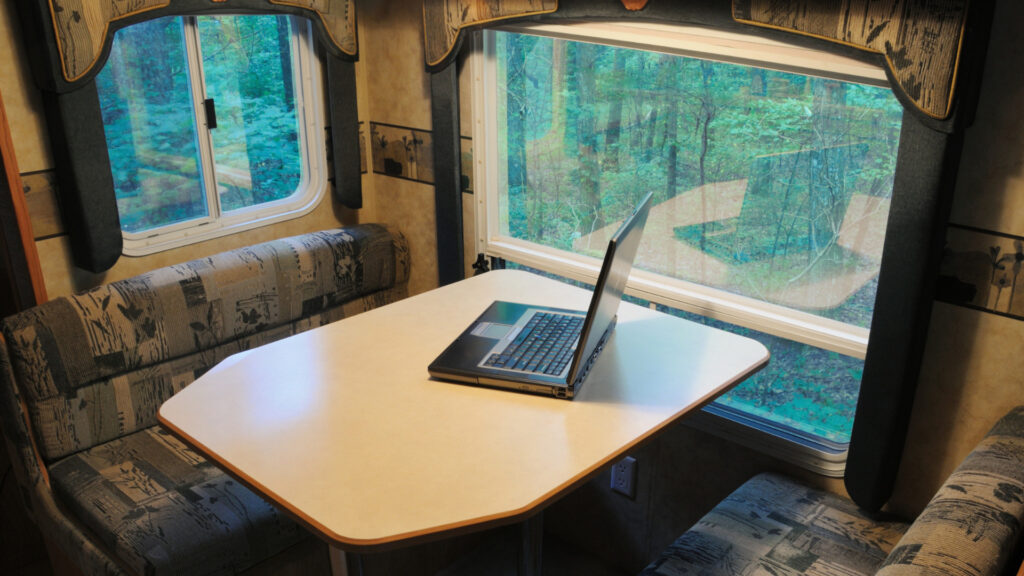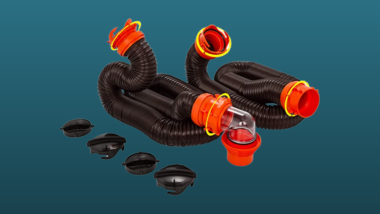Table of Contents Show
Recently, Thor Industries and SpaceX teamed up to add the satellite internet service to several 2023 RV brands. Internet connectivity is a must for many traveling nomads. It’s not just a vacation anymore.
As younger people hit the road and working parents and online students need reliable internet, Starlink has emerged as one of the top developers of fast, portable connectivity.
Let’s learn more about which RV brands will have Starlink as a feature this year!
What Is Starlink?
Starlink is high-speed, low-latency broadband satellite internet. The low-orbiting constellation of highly advanced satellites is the largest in the world. Everything you need comes in the kit when you order, with no professional installation needed.
With the Starlink, Wi-Fi router, cables, and base, you can get up and running in just a few minutes.
RVers love the unit’s portability, while those who live in rural locations now have access to fast and reliable internet in their homes that they’ve never had before.
SpaceX owns Starlink. The company’s founder, Elon Musk, is the second-richest person in the world. He also owns Tesla, Twitter, and other companies.
Although SpaceX has its hand in other business endeavors like building Starship and sending civilians into space, it’s also building rockets and spacecraft daily that regularly launch to deploy the satellites for the broadband internet system.
Therefore, the system grows daily as new satellites enter orbit, expanding the capabilities and reach of this satellite internet system.
What Are the Benefits of Starlink?
The benefits of Starlink for an RVer or someone living in a rural sticks-and-bricks house are the extremely fast speeds and the continuing growth of the system itself.
The company claims that users can reach speeds up to 300 Mbps. But the more realistic number is 100 Mbps.
For unlimited internet, having such speeds is a game-changer for people who need to do video conferencing or online school. Streaming and gaming are also possible with Starlink.
Particularly for RVers, Starlink has portability. Travelers can take the unit anywhere in the world and still connect to the internet if they have a direct line of sight to the sky.
You can also pause the service. If you won’t travel for two or three months, you simply go into your account and pause your Starlink. And you won’t have any fees to pause the service.
RVers also have the option to buy the in-motion Starlink hardware. This allows them to connect to the internet while driving. If a partner needs to answer some emails or have a video call while on the way to the campground, Starlink’s in-motion capabilities can do this.
Read More: Before you decide if Starlink is right for you, see What RVers Really Think About Starlink for RVs
What Are the Cons to Starlink?
Although Starlink seems to be a Godsend for many people, it’s not perfect. Starlink for RVs, now called Starlink Roam, has a one-time cost of $599 for the portable hardware or $2,500 for in-motion hardware.
The regional price costs $150 per month, while the global price costs $200 per month. These costs are usually out of the budget for many RVers.
Starlink also uses a lot of power. It has to be connected to an outlet to operate. For dry campers who enjoy camping off-grid, this is a huge drawback. Conserving electricity is important for boondocking on public land for days or weeks.
Finally, sometimes Starlink doesn’t work. Although it’s very reliable in wide open spaces, you won’t get a good connection when you have obstructions like trees or buildings.
The dish needs a clear view of the sky. If you prefer to camp in state parks nestled underneath the shade of trees, Starlink won’t work well.
The performance is also not ideal in congested areas. Currently, this is along the East Coast. The speeds will be slower in locations where more people use the system. Considering what you pay for the Starlink service, you want high speeds and low latency. You won’t get that in congested areas.

Why Is Internet Connectivity Important for RVers?
Even though RVers previously wanted to unplug and get away from technology, these days, more people want to travel while working remotely.
Parents may need to work for several hours a day. Kids must log on to complete school assignments or join an online class.
It’s not just about streaming the latest Netflix show or playing Minecraft with friends across the country. Internet connectivity is essential to travel for many people who want to enjoy life on the road.
What Is Thor Industries?
Thor Industries is the largest RV manufacturer in the world. In North America, Thor owns 16 RV brands and 14 other companies.
These brands include Airstream, Entegra, Keystone, Jayco, DRV, and Tiffin. Others companies include Roadtrippers, Dicor, Maxx Air, and Airxcel.
In 1980, Wade Thompson and Peter Orthwein founded the company with the purchase of Airstream, and since then, Thor Industries has continued to grow with acquisition after acquisition.
Its most recent purchase was in September 2021, when Airxcel joined the family of brands.
What Thor Brands Will Offer Starlink as an Option?
Although Thor Industries owns dozens of companies in the RV industry, only four brands will offer Starlink as an option: Airstream, Entegra Coach, Jayco, and Tiffin.
But it won’t be available on all models within these brands. Each of these manufacturers makes numerous floorplans within several different lines. Starlink will be an optional add-on for some models.
Keep in Mind: Can You Get Satellite Internet for Your RV? Let’s find out!
Other Ways to Connect to the Internet While Traveling
If you don’t have the budget for Starlink or spend most of your time traveling along the East Coast, you have other ways to connect to the internet. However, you might end up paying about the same amount per month.
Public Wi-Fi
The least reliable type of internet is the public Wi-Fi offered at campgrounds. Even though a campground says it has free Wi-Fi, that doesn’t mean it’s usable.
Everyone at that campground will try to connect, thus bogging down the system. If you just need to answer a few emails, this will suffice. But if you need to have a Zoom meeting, it likely won’t work great.
You can also find public Wi-Fi spots in town. Starbucks, McDonald’s, Barnes & Noble, and local libraries will offer Wi-Fi. Although it might be inconvenient to drive into town, saving money might be worth it.

Cellular Data
The majority of RVers use cellular data to connect to the internet. Even folks with Starlink will have Verizon, T-Mobile, or AT&T hotspots or routers as a backup.
As long as you have a strong connection to the cell towers in the area, you can work remotely and even stream with these services.
T-Mobile now offers a home internet option, which is portable. Users can access unlimited internet for $50 to $55 a month. For most plans, unlimited internet will cost over $100 a month. So this option is great if you travel in areas with strong T-Mobile coverage.
Hardwired
Other RVers prefer a hardwired internet connection. Sometimes their bosses require it. These RVers wouldn’t travel across the country, however. They’re usually stationary on their own land or in an RV site at a campground.
A hardwired connection in an RV works the same way as a hardwired connection in a residential house. You’ll have the same equipment, the same capabilities, and the same monthly price.
Will Starlink Be Offered on All RVs in the Future?
This recent announcement by Thor Industries and Starlink has people wondering if this is the wave of the future.
Will other brands follow suit? Or will the increasing price of Starlink keep manufacturers from adding this option to their units? Perhaps this will be another luxury only the top-tier companies provide.
Would you like to see Starlink offered on all RVs in the future?






